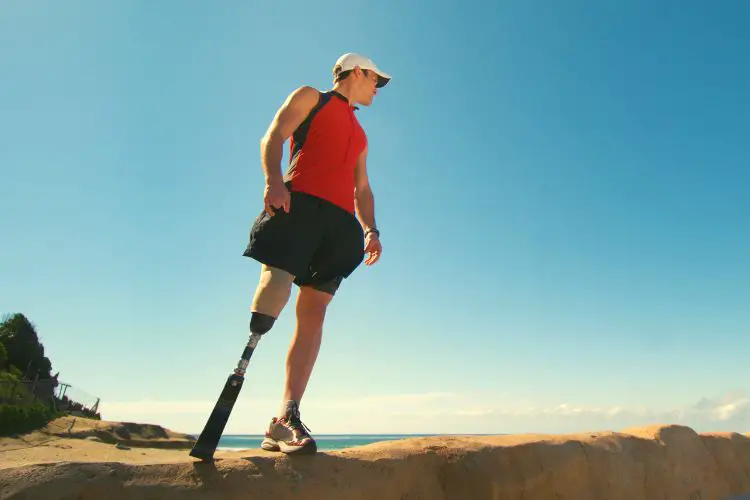What is a Prosthetic is what I have often been asked? The assistive devices that replace absent limbs due to some trauma or surgical amputation (gas gangrene, dry gangrene). On general basis prostheses have 2 types.
Exoskeletal prostheses have a hard outer plastic or metal shell in the shape of the limb. They are
permanently fixed and not adjustable. Exoskeletal prostheses are more durable and may be preferred
by people who do physical labor or are in harsh environments that could damage the prosthesis.
Endoskeleton prostheses
A central inner skeletal structure and are adjustable, but less durable. The endoskeleton system is
often covered with a soft material in the shape of the limb and a synthetic skin.
Prosthetic limbs
There are different types of prosthetic limbs but on structural or anatomical basis 4 major types of
prosthetic limbs are available in commercial setups.
To better understand such types first we need to understand some anatomical structure (bones) of
limbs.
- Upper limb arm > humerus
- Forearm > radius, ulna
- Lower limb > femur ,tibia, fibula
Different components of prostheses are the socket, suspension and control system(s), Joints, and
appendage keeping these essential component in view there are many types of prostheses but all
focused on a stable, comfortable fit for maximum function. For example, prostheses can be designed
for general daily mobility, for specific activities such as swimming or for high-impact and competitive
sports such as running. The person’s physical and cognitive abilities and gadget tolerance are
important in the initial selection of prosthetic components.
Trans radial
It is artificial limb that is wear to compensate the need of limb that is amputated or removed due to
some reason. It is wear at the level of radius bone (proximal end) and advance controlled by force
myography (FMG) or electromyography (EMG).Trans-radial prosthetic limb wear below elbow and
controlled by muscle movement sense(myography) and more sophisticatedly by electrode shift or other
electrical interferences.
Trans humeral
Amputee arm is replaced by trans humeral prosthesis at the level of shoulder joint depending on power
and function trans humeral prostheses is placed by an authorized prosthetist. He decided most suitable
socket design and functional components according to need and controlled by cables or muscular
sensory systems. Now a days humeral prostheses are controlled by manual (body power) and external
helping mechanism called hybrid Trans humeral prosthetic limb.
There are 5 general types of upper limb prostheses:
- Passive prostheses
- Body-powered prostheses
- Externally powered myoelectric prostheses
- Hybrid prostheses
- Activity-specific prostheses
Passive prostheses
Assist in balance, stabilization of objects (such as holding down paper when writing), and
recreational/vocational activities.
Body-powered prostheses
A strap-cable system holds the prosthesis on and uses the motion of the person’s shoulder blade and
upper arm to operate the hook, hand, and/or elbow joint.
Externally powered myoelectric prostheses
Provide active hand and joint movement without needing shoulder or body motion. Sensors and
other inputs use muscle movement of the residual limb or upper body control electrically powered
actuators that provide greater grasp force than body-powered prostheses.
Hybrid prostheses
Are typically used for higher level upper-limb amputations. They combine specific features of body
power and myoelectric power. For example, a body-powered elbow might be combined with an
externally powered hand or terminal device.
Activity-specific prostheses
For people who participate in activities that could damage the residual limb or everyday prosthesis, or
when the everyday prosthesis would not function effectively. These prostheses often include a
specialty design interface, socket, suspension system, and terminal device.
Trans femoral
Artificial limb replaced with the amputee, its more valuable aspect is to bear weight and maintain
balance. The difference between other prosthesis to Trans femoral is the design that is set in such a way
to distribute pressure over and suspension of the prosthesis. While assessing the movement range the
static alignment and dynamic alignment is also necessary to be evaluated.
Trans tibial
A trans tibial prosthesis is an artificial leg below the knee at the level of tibia. Knee joint use flexion and
extension movement so it’s simpler than the femoral prostheses for being a hinge movement.
There are many variables and options for lower limb prostheses—there are 350 different foot/ankle
systems and 200 different knees. The amputee and prosthetist evaluate different joint and foot
components to determine which provide optimal balance, safety, function, and gait efficiency.
Lower limb prostheses are endoskeleton because they are adjustable.
There are 3 general types of lower limb prostheses:
- Prosthetic ankle and foot systems
- Prosthetic knee systems
- Sport-specific prosthetic foot and knee systems
Prosthetic ankle and foot systems
May include a hydraulic system that dampens impact forces. Some automatically adjust to changes in
walking speed.
Prosthetic knee systems
Include passive body-powered systems with a single- or multi-axis joint.
Sport-specific prosthetic foot and knee systems
Help people achieve the highest level of physical performance. Some systems are effective for
multiple sport and recreational activities.
References
Deijs, M., R. M. Bongers, N. D. Ringeling-van Leusen, and C. K. van der Sluis. “Flexible
and Static Wrist Units in Upper Limb Prosthesis Users: Functionality Scores,
User Satisfaction and Compensatory Movements.” [In eng]. J Neuroeng Rehabil
13 (Mar 15 2016): 26. https://doi.org/10.1186/s12984-016-0130-0.
Marks, L. J., and J. W. Michael. “Science, Medicine, and the Future: Artificial Limbs.”
[In eng]. Bmj 323, no. 7315 (Sep 29 2001): 732-5.
https://doi.org/10.1136/bmj.323.7315.732.
Prakash, Alok, Neeraj Sharma, and Shiru Sharma. “An Affordable Transradial
Prosthesis Based on Force Myography Sensor.” Sensors and Actuators A:
Physical 325 (2021/07/01/ 2021): 112699.
https://doi.org/https://doi.org/10.1016/j.sna.2021.112699.

